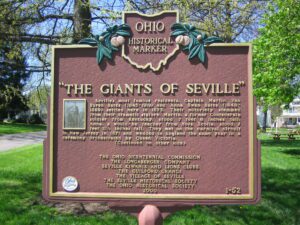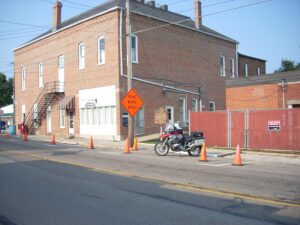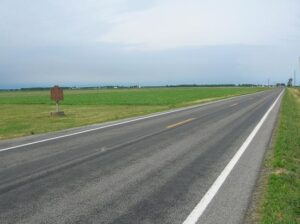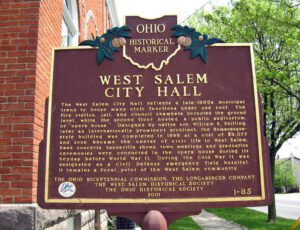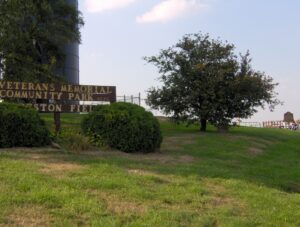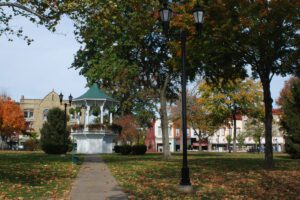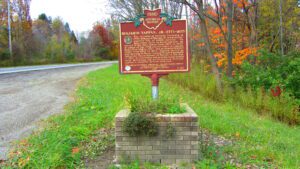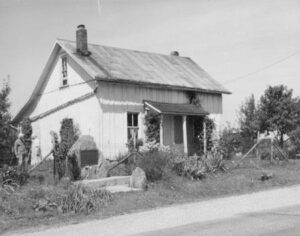, OH
Seville’s most famous residents, Captain Martin Van Buren Bates (1845-1919) and Anna Swan Bates (1848-1889) settled here in 1873. Their notoriety stemmed from their dramatic stature: Martin, a former Confederate soldier from Kentucky, stood 7 feet 8 inches tall; Anna, a would-be teacher from Nova Scotia, stood 7 feet 11 inches tall. They met on the carnival circuit in New Jersey in 1871 and wedded in England the same year in a ceremony orchestrated by Queen Victoria. (Continued on other side)
, OH
This building was a center of community life from the time of its construction in 1886 to the late 1930s. Once common, such combinations of governmental offices and commercial and entertainment space are today rare. The second floor opera house retains many original features, including stage backdrops, dressing rooms, and seats. Vaudeville, theater companies, and entertainment of all kinds were hosted here and many performers signed the backstage walls: Buffalo Bill dated his signature October 28, 1888. Along with village offices, first floor tenants have included the Vermillion Township Trustees, the Eddie Stover Hat Shop, and the F.L. Smith Watch Repair and Jewelry Store. Hayesville’s citizens approved the hall’s construction on April 18, 1884 by a vote of 100 to 13. Contractor Samuel Craig completed the building two years later at a cost of $4,852.20. Located on the Lincoln Highway, this building was listed on the National Register of Historic Places in 1976.
, OH
Comprising 8,000 acres of Brookston-Crosby soils, the marsh is named for Hog Creek which drains it. Once a shallow lake, cranberries, wild flags and grasses flourished here. Reclamation (1868) cost $13.00 per acre. Dredging was done by steam scow; lateral ditches were hand dug by spade. The original grade of 1/3″ in 100′ proved ineffective for onion, beets and potatoes. In 1949 restored drainage outlets breathed new life for today’s soybean and corn agriculture.
, OH
The West Salem City Hall reflects a late-1800s municipal trend to house many civic functions under one roof. The fire station, jail, and council chambers occupied the ground level, while the second floor hosted a public auditorium, or “opera house.” Designed by native son William K. Shilling, later an internationally prominent architect, the Romanesque-style building was completed in 1899 at a cost of $9,077 and soon became the center of civic life in West Salem. Band concerts, vaudeville shows, town meetings, and graduation ceremonies were conducted in the opera house during its heyday before World War II. During the Cold War it was designated as a Civil Defense emergency field hospital. It remains a focal point of the West Salem community.
, OH
With a population of 475 residents, the Beallsville community gained the unfortunate distinction of having suffered the highest known per-capita casualty rate during the Vietnam War. Six Beallsville men, all under the age of 21, were killed in action in Vietnam between 1966 and 1971, a profound tragedy for this close-knit community. In 1969 Beallsville citizens worked with congressional representatives to prevent further loss of life, to no avail. Five other Monroe County men lost their lives in the conflict as well, magnifying the loss for one of Ohio’s least-populated counties. (continued on other side)
, OH
Its location and the tides of war established Gallipolis, then a town of some 3,000, as a point of strategic military importance to the Union upon the outbreak of the conflict in 1861. It was destined during the next four years to play a role without counterpart in Ohio. Here through this troop concentration area passed thousands of soldiers to the great campaigns. Here the traditional peacetime activity of the town, long a depot of supplies for the Kanawha Valley, was turned to military purposes for maintaining armies in the field. Here riverside warehouses held vast military stores to be transported by steamboat. Here newly-mustered troops set up Camp Carrington in a wheat field on the upper side of town. Here the women of Gallipolis helped minister to thousands of wounded and sick in an army hospital
, OH
The founder of Ravenna Township in 1799, Benjamin Tappan Jr. led a distinguished life of public service. An aggressive force in local politics, he served in the Ohio Senate from 1803 to 1805, as judge of the fifth circuit court of common pleas from 1816 to 1823, and as federal district judge from 1826 to 1833. Tappan served as aide-de-camp to Major General Elijah Wadsworth following the surrender of Detroit in the War of 1812, provisioning and arming local militia units defending the northwestern frontier against a possible British invasion. (continued on other side)
, OH
One of America’s best-known sport shooters and entertainers of the late 1800s, Annie Oakley was born Phoebe Ann Mosey (or Mozee) north of Versailles in Darke County in 1860. She achieved local fame for her shooting ability as a hunter while still in her teens. By 1885 Oakley was a star performer in Buffalo Bill’s Wild West. With husband and manager Frank Butler, she refined a shooting act and image that appealed to late 19th century notions of a romanticized but vanishing West. Throughout her 30-year performing career, Oakley provided honest entertainment in a deception-prone industry while demonstrating widening opportunities for women. She retained her Ohio ties throughout her life and is interred at Brock Cemetery, eleven miles north of Greenville.


